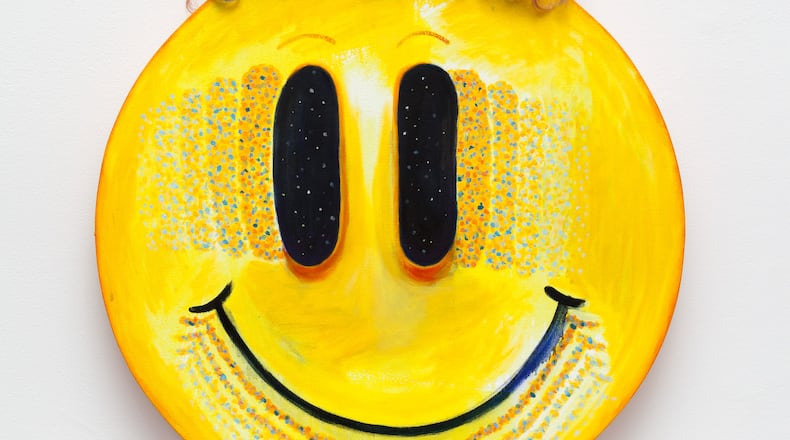The jumping off point for the group show that Atlanta artist and Georgia State University instructor Craig Drennen has curated at Westside’s Hathaway Gallery is a strange 1978 footnote in American musical history.
In black-and-white footage on a small television on the Hathaway gallery floor, the seminal punk band, the Cramps, performs for an audience of mental patients at Napa State Mental Hospital. That bizarre moment is the inspiration for Drennen’s show “Somebody Told Me You People Were Crazy.”
His exhibition features nine artists from Los Angeles to Atlanta to Buffalo Center, Iowa, and a spirit that definitely channels a punk rock blend of irreverence, irony, nihilism and heavy doses of pop culture jamming. “Every artist can likely empathize with performers delivering their craft under strange conditions to an uncomprehending audience,” notes Drennen in a very punk rock gesture of curling his lip at the masses.
It’s hard to miss the countercultural snark at work in Chicago artist Mel Cook’s “There’s a Pill for That,” and “There’s a Pill for That Too,” two spins on the smiling yellow happy faces that defined so much of ’60s mainstream culture. While the rest of the world protested and questioned in an era of deep rebellion, that blissfully smiling sunshine-like face originally created for a Massachusetts insurance company, and its motto “Have a Nice Day” seemed purposefully, irritatingly unaware.
Rave culture and endless other cultural modifications have since manipulated that happy face icon and Cook’s subversive smiley faces are yet another twist. In her psychedelia-inflected paintings, faces have eyes like pharmaceutical capsules and expressions ranging from distressed to blithely grinning, as if medicated into a state of not caring.
Also steeped in dark comedy are Buffalo Center, Iowa, artist Tim Wirth’s shaggy square paintings that read like music poster or album cover art and herald the artist and Buffalo Center, Iowa in goofily lo-fi terms.
Like Mel Cook, Atlanta artist Marc Brotherton takes a dip in our pop cultural stew in a series of “Killskreen” paintings that blend the neon colors of airbrushed beach town T-shirts and references to vintage video games and tap into a stream of junky pop culture colliding with non-representational abstract painting.
Channeling a related strain of pop-culture infused angst, Los Angeles artist David Leggett’s mix of sketches, stickers and collaged images on paper call out the Simpsons, devil worship, Elvis, Michael Jackson, Wayne Williams and tap into how blackness is depicted in popular culture. His creepy, funny works in “Somebody Told Me” look like the Trapper Keeper doodles of a particularly alienated teen and tie into an overall angsty, irreverence seen throughout the show.
Even the more subdued work in “Somebody Told Me” has a subversive quality in the context of “Somebody Told Me You People Were Crazy,” from Jenene Nagy’s op art grids — black vortexes crafted from graphite applied to torn paper that invite viewers into their void and use ordinary materials to create interesting new effects. Christopher Carroll’s gray and black paintings use an ancient buon fresco technique of painting on wet plaster combined with screenprinting in works that are also defined by a purposefully rough-around-the-edges quality. With their raw wood frames and wood-burned lettering, the New York City artist’s murky paintings have a distinctly mystical, foreboding mood that conjure the ancient.
In his curator statement, Drennen admits that he mostly just likes the artists he has assembled for this show, though it’s hard not to miss a shared irreverent sensibility in this Atlanta artist’s work and that of his peers’. It’s a crazy world we live in is the crux of Drennen’s show. And he’s got the art to prove it.
VISUAL ARTS REVIEW
“Somebody Told Me You People Were Crazy”
Through July 13. 10 a.m.-5 p.m. Tuesdays-Saturdays. Hathaway Contemporary Gallery, 887 Howell Mill Road, NW, Suite 200, Atlanta. 470-428-2061, www.hathawaygallery.com
Bottom line: A diverse group of artists are united in a slightly subversive approach and the use of lo-fi materials to engage with both pop culture and painting's history.
About the Author
Keep Reading
The Latest
Featured


